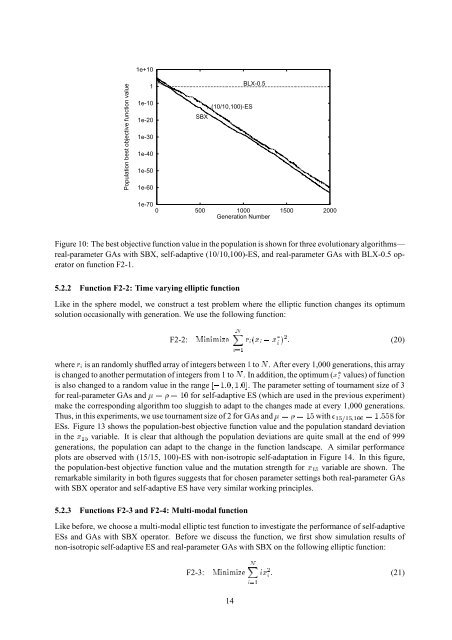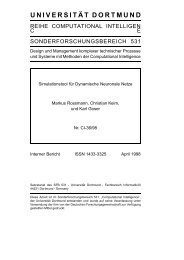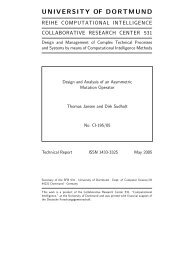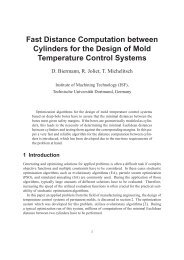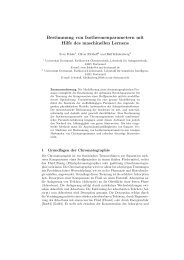Self-Adaptive Genetic Algorithms with Simulated Binary Crossover
Self-Adaptive Genetic Algorithms with Simulated Binary Crossover
Self-Adaptive Genetic Algorithms with Simulated Binary Crossover
You also want an ePaper? Increase the reach of your titles
YUMPU automatically turns print PDFs into web optimized ePapers that Google loves.
Population best objective function value<br />
1e+10<br />
1<br />
1e-10<br />
1e-20<br />
1e-30<br />
1e-40<br />
1e-50<br />
SBX<br />
(10/10,100)-ES<br />
BLX-0.5<br />
1e-60<br />
F2-2:MinimizeNXi=1ri(xi?xi)2:<br />
1e-70<br />
0 500 1000 1500 2000<br />
Generation Number<br />
Figure 10: The best objective function value in the population is shown for three evolutionary algorithms—<br />
real-parameter GAs <strong>with</strong> SBX, self-adaptive (10/10,100)-ES, and real-parameter GAs <strong>with</strong> BLX-0.5 operator<br />
on function F2-1.<br />
5.2.2 Function F2-2: Time varying elliptic function<br />
Like in the sphere model, we construct a test problem where the elliptic function changes its optimum<br />
solution occasionally <strong>with</strong> generation. We use the following function:<br />
(20)<br />
whereriis an randomly shuffled array of integers between1toN. After every 1,000 generations, this array<br />
is changed to another permutation of integers from 1 toN. In addition, the optimum (xivalues) of function<br />
is also changed to a random value in the range[?1:0;1:0]. The parameter setting of tournament size of 3<br />
for real-parameter GAs and==10for self-adaptive ES (which are used in the previous experiment)<br />
make the corresponding algorithm too sluggish to adapt to the changes made at every 1,000 generations.<br />
Thus, in this experiments, we use tournament size of 2 for GAs and==15<strong>with</strong>c15=15;100=1:558for<br />
ESs. Figure 13 shows the population-best objective function value and the population standard deviation<br />
in thex15variable. It is clear that although<br />
F2-3:MinimizeNXi=1ix2i:<br />
the population deviations are quite small at the end of 999<br />
generations, the population can adapt to the change in the function landscape. A similar performance<br />
plots are observed <strong>with</strong> (15/15, 100)-ES <strong>with</strong> non-isotropic self-adaptation in Figure 14. In this figure,<br />
the population-best objective function value and the mutation strength forx15variable are shown. The<br />
remarkable similarity in both figures suggests that for chosen parameter settings both real-parameter GAs<br />
<strong>with</strong> SBX operator and self-adaptive ES have very similar working principles.<br />
5.2.3 Functions F2-3 and F2-4: Multi-modal function<br />
Like before, we choose a multi-modal elliptic test function to investigate the performance of self-adaptive<br />
ESs and GAs <strong>with</strong> SBX operator. Before we discuss the function, we first show simulation results of<br />
non-isotropic self-adaptive ES and real-parameter GAs <strong>with</strong> SBX on the following elliptic function:<br />
(21)<br />
14


